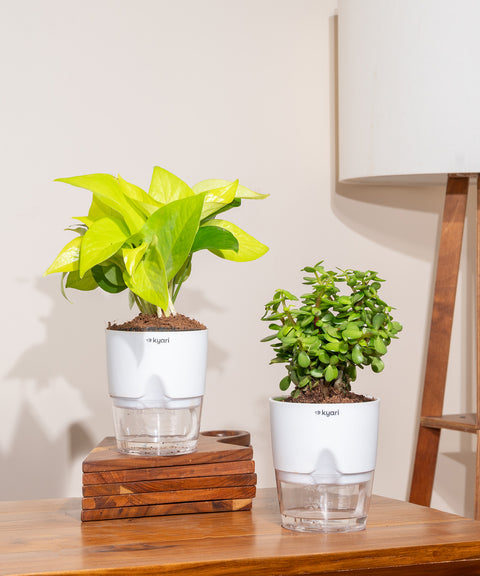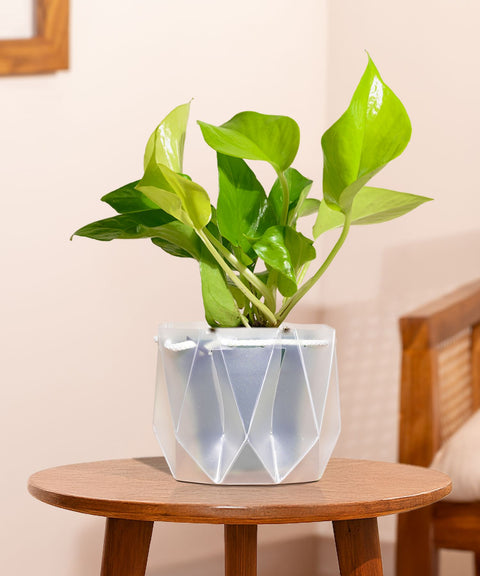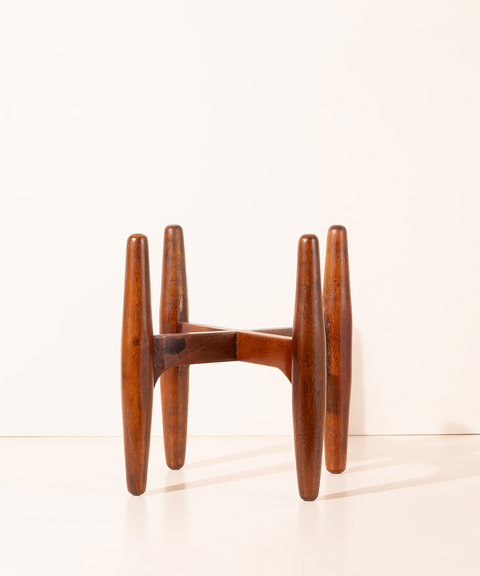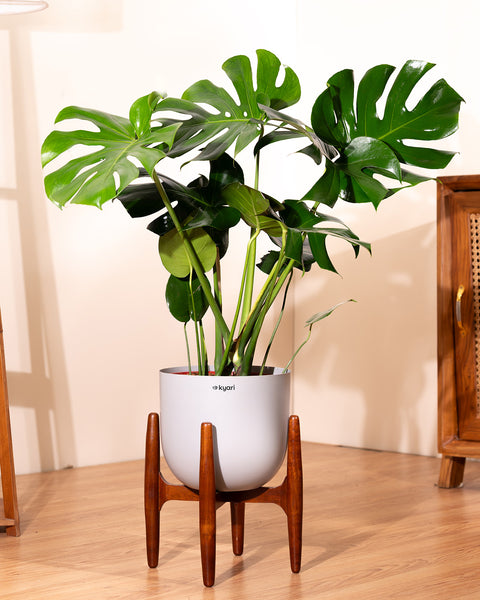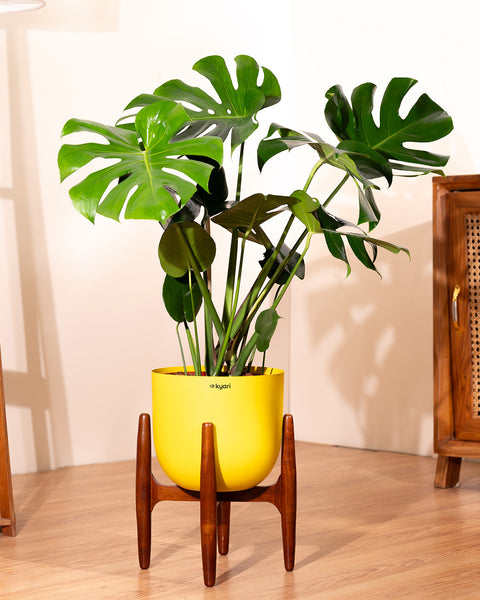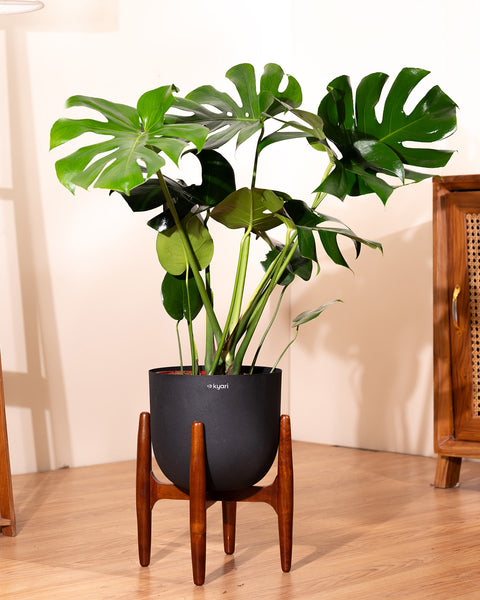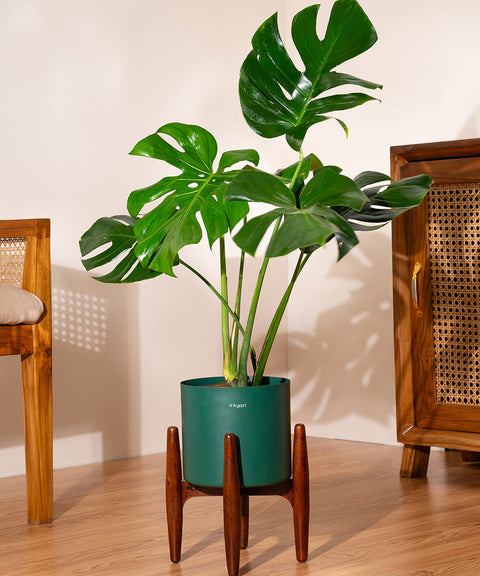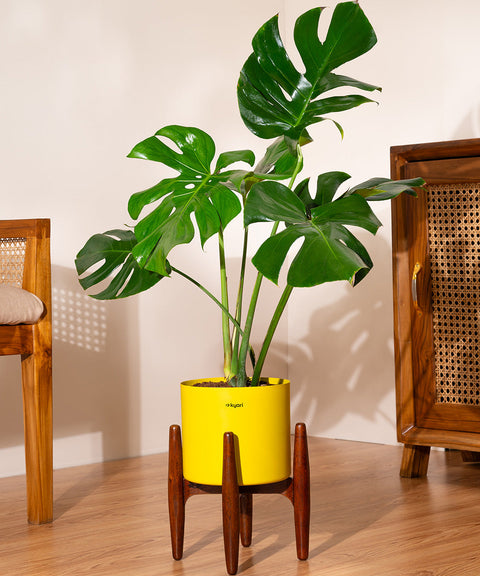In This Blog
The Snake Plant (Sansevieria trifasciata) is now a popular choice for home and office settings for all the right reasons. It is elegant, low-maintenance, and is one of the best air-purifying plants. With its thin, upright leaves and bold patterns, not only does it enhance the beauty of your room, it is good for your health as well.
Whether you're one of those people who tends to forget to water their plants, or you're new to being a plant parent, the Snake Plant is the best friend for you. In this blog, you'll see various advantages of snake plants, how to care for it, where to place it at home, how to propagate it, as well as some varieties of snake plants and how they can diversify your space.
Benefits of the Snake Plant
1. Improves Indoor Air Quality
Snake plants aren't just great to look at. They actually help clean the air around you. They can remove harmful toxins like formaldehyde, benzene, and xylene, which often come from cleaning products and furniture. This makes the air in your home fresher and healthier for you and your family.
Tip: Keep one in your bedroom or workspace for cleaner air and a refreshing vibe.
2. Helps You Sleep Better
Most plants give off oxygen during the day, except for snake plants. They still give off oxygen even after sundown, thanks to a process known as CAM photosynthesis. They make excellent bedroom plants, as they are able to aid breathing during sleep.
3. Low Maintenance
If you're someone who forgets to water plants, then the Snake Plant is your best choice. It requires little attention, thrives on minimal water, and doesn’t need frequent repotting. Even if you’re a new plant parent, you’ll find it really easy to care for.
4. Brings Positive Energy
Having plants around can really help you feel less stressed and more at ease. Snake plants, with their soothing green leaves and neat shape, bring a sense of calm to any space. Just seeing one nearby during a busy day can gently boost your mood and help you feel a little more connected to nature.
5. Great for Small Spaces
Snake plants have an elegant modern appearance because of their vertical sword-shaped leaves. These indoor plants can complement any living room or office setting since their compact size does not require extensive space. Their sleek structure blends well with most interior styles and makes the space look livelier.
Shop Snake Plant
Snake Plant Care: How to Keep It Happy
Caring for a snake plant is easy, which makes it ideal for both beginners and experienced plant lovers. It doesn’t need constant attention, but a few basic steps can keep it thriving for years. Here’s everything you need to know:
Light Requirements
Snake plants are quite adaptable when it comes to lighting. They can survive in low light areas, such as corners or hallways, but they will best thrive in bright, indirect light. If you want faster growth and richer leaf color, try placing your snake plant near a window with filtered sunlight.
Tip: Avoid placing it in harsh, direct sunlight for long hours. The leaves can burn or develop brown edges.
Watering Needs
One of the biggest mistakes people make is overwatering snake plants. These plants prefer their soil to dry out completely between waterings. Watering once every two to three weeks is enough in most cases, and even less during winter. So, before you water the plant, stick your finger into the soil. If the top two inches feel dry, it’s time to water.
Kyari’s Hydrate Water Meter makes it easier. Insert it in the soil If it’s blue, your plant has enough moisture for now; if it's white, water your plant.
Tip: Always empty the saucer under the pot to prevent root rot.
Soil and Pot Selection
Snake plants prefer well-draining soil. A potting mix for cacti or succulents is perfectly suited for them. Good drainage is key to prevent the roots from staying wet for too long.
Choose pots with drainage holes at the bottom. Kyari’s self-watering pots make care even easier, they ensure your snake plant gets just the right amount of water, while giving an aesthetic touch to your indoors.
Ideal Temperature and Humidity
Room temperature between 15°C to 30°C works well for Snake Plants. They are not fond of the cold, so make sure they’re not placed near AC drafts or open windows during winter. Average indoor humidity is satisfactory, with no need for misting.
Tip: If you're in a cooler region, avoid placing the plant on cold tile floors.
Fertilizing Tips
Snake Plants don’t need fertilizing frequently. Just fertilizing them once or twice a year during the growing season (spring and summer) is enough. Use a diluted, balanced houseplant fertilizer to give your plant a small nutrient boost.
Avoid fertilizing in winter, as they need rest in those months and don’t require any additional nutrients.
Cleaning the Leaves
Dust can easily collect on snake plant leaves, especially because of their broad, upright shape. A layer of dust not only dulls their natural shine but can also slow down photosynthesis. Cleaning them regularly helps your plant stay healthy and look fresh.
Use a soft, damp cloth to wipe each leaf from top to bottom gently. You can do this every few weeks or whenever you notice a layer of dust building up.
Quick Tip: Avoid using leaf polish or any harsh cleaners—just water and a soft cloth are enough.
Where to Place a Snake Plant at Home
1. Bedroom
Snake Plant is a favorite among bedroom plants, and rightly so. They are one of the few plants to release oxygen at night, helping to clean the air you breathe while you sleep. Their serene green color introduces a relaxing atmosphere to your private space as well.
Make sure to position your snake plant near an indirect light window. You can even grow it with little light, so it's great for corners or bedside tables. But try to avoid keeping it near ACs and heaters.
☘️Fun Fact: Many people use snake plants as a natural air purifier for their bedrooms, thanks to their air-filtering qualities.
2. Living Room
If you're looking to brighten up a corner of your living room, or add height to your plant arrangement, the snake plant fits right in. Its upright growth and bold leaves make a statement and also it needs little attention.
It thrives best near windows with filtered sunlight. Even if your living room doesn’t get too much light, the plant will still grow well. Use decorative pots or planters from Kyari to match your interiors and create a cozy, green corner.
3. Office or Work Desk
Snake plants are an excellent choice if you are looking for office plants. They don’t need frequent watering or care, so they are perfect for a busy office environment. Also, studies suggest that having plants around can reduce stress and boost productivity.
Place a smaller variety on your desk or a medium one near your office entrance. Choose a spot with moderate light and away from strong air conditioning.
4. Balcony or Indoor Garden
Snake plant will thrive well in gentle morning sunlight in your balcony. It's also a great idea to include your plant in an indoor garden setup with other low-maintenance plants.
Remember that the hot afternoon sun might scorch the leaves, so choose a semi-shaded position.
Tip: Rotate the plant occasionally to ensure even growth and prevent it from leaning toward the light.
Common Snake Plant Varieties
Snake plants may all be low-maintenance, but they come in a variety of shapes, sizes, and shades, each with its own charm. Here's a quick guide to some popular types you can bring home:
1. Sansevieria Trifasciata
Sansevieria Trifasciata is the most popular type of Snake plant. It has tall, upright leaves with green horizontal stripes and yellow edges. It is often seen in living rooms or offices, this type adds height and elegance to any corner.
It’s not just stylish, it’s also one of the best air-purifying plants you can get for your home.
2. Golden Hahni Snake Plant
This one is a compact and charming variety, the Golden Hahni has short, rosette-shaped leaves with golden-yellow and green markings. Its small size makes it a perfect desk plant. You can also keep them at window sills, and tight spaces where you want a touch of greenery.
3. Green Snake Plant
The Green Snake Plant is simple, ageless, and minimal, with uniform dark green foliage and a clean, modern appearance. It's ideal for those who appreciate neutral colors and a clutter-free environment.
This variety blends well into both traditional and contemporary interiors and is very forgiving if you forget to water it.
4. Moonshine Snake Plant
This variety stands out for its soft, silvery-green leaves. It brings a cool tone to your decor and works beautifully in minimal or modern homes. The Moonshine Snake Plant tends to stay shorter, making it great for tables and shelves.
Its subtle coloring adds light to darker corners and feels calming to look at.
5. Black Gold Snake Plant
For those who like bold contrast, the Black Gold variety is a showstopper. It features deep green leaves with thick golden-yellow edges that look almost painted on. This one works best in areas where you want your plant to stand out, like entryways or feature corners.
Quick Tip: Snake plants are known for being hardy, but choosing the right variety can help you match your decor style and available space even better.
Propagation: Grow More from One
Propagating a snake plant is a satisfying way to grow more greenery at home, either for yourself or as a thoughtful plant gift. It's budget-friendly, beginner-friendly, and a fun little weekend project!
Here are two easy methods you can try:
1. Leaf Cutting in Water
One of the most popular methods because you get to watch the roots grow.
Steps:
-
Cut a healthy leaf near the base using clean scissors or a knife.
-
Let the leaf cutting dry for a day or two. This helps prevent rotting.
-
Place the cut end in a glass of clean water, making sure only the bottom touches the water.
-
Keep the glass in a spot with bright, indirect light.
-
Change the water every few days to keep it fresh.
-
Roots will start forming in 3–4 weeks. Once they're a few inches long, transfer the cutting into a pot with soil
-
Tip: You can cut the leaf into smaller 3–4 inch sections for multiple propagations—just remember which side is the bottom!
2. Leaf Cutting in Soil
This method takes a little longer, but it’s just as effective.
Steps:
-
Cut a healthy leaf and let it dry for a day or two.
-
Insert the bottom end of the cutting directly into a well-draining potting mix.
-
Water lightly and place the pot in bright, indirect sunlight.
-
Keep the soil slightly moist until roots begin to form.
-
After a few weeks, gently tug the cutting; if it resists, roots have formed!
Troubles You Might Face with Snake Plants
Yellowing Leaves
If your snake plant leaves are turning yellow, it could be due to overwatering or poor drainage. Snake plants don’t like soggy roots, and too much water can lead to root rot. Always check the soil before watering — if it feels moist, wait a few more days.
Tip: "Stick your finger into the soil up to the first knuckle- if it's still damp, hold off on watering.
Soft and Mushy Leaves
Soft or mushy leaves usually mean the plant is sitting in water for too long. Snake plants store moisture in their leaves, so when overwatered, the leaves begin to lose their firmness and may collapse. Make sure your pot has a drainage hole and the soil is fast-draining.
Curling Leaves
When the leaves curl inward, it’s often a sign of underwatering or sudden temperature changes. Snake plants are hardy, but extreme heat or cold can stress them. Keep your plant away from heaters, AC vents, or cold drafts.
Pests on Leaves
While generally pest-resistant, snake plants can sometimes attract mealybugs or spider mites. These tiny bugs suck on the sap and weaken the plant. If you notice sticky residue, cottony spots, or discolored leaves, check for pests and wipe the leaves clean.
Tip: Neem oil or a simple soap-water spray works well to keep pests in check naturally.
Leaning or Falling Over
If your plant seems to be leaning or falling, it might be due to heavy top growth with weak roots. This often happens when the plant isn’t getting enough light, and the leaves stretch too far. Move it to a brighter spot and rotate it regularly so it grows evenly.
Conclusion
The Snake Plant is more than simply a trendy indoor plant; it’s a companion that brings both beauty and benefits into your space. It's genuinely one of the easiest green additions for beginners to have, as its air purifying and requires very minimal attention.
This plant looks great in any setting, whether you put it in your bedroom to improve sleep, gift it to your friend, or arrange it in your favorite pot in your living room. And with so many options available, each with a unique style and personality, you're bound to find one that complements your room perfectly.
If you're looking for a plant that works hard, looks great, and doesn’t ask for much, the snake plant is your go-to green friend.








 Limited Time Deal
Limited Time Deal
 BYOB - Small Plants
BYOB - Small Plants












